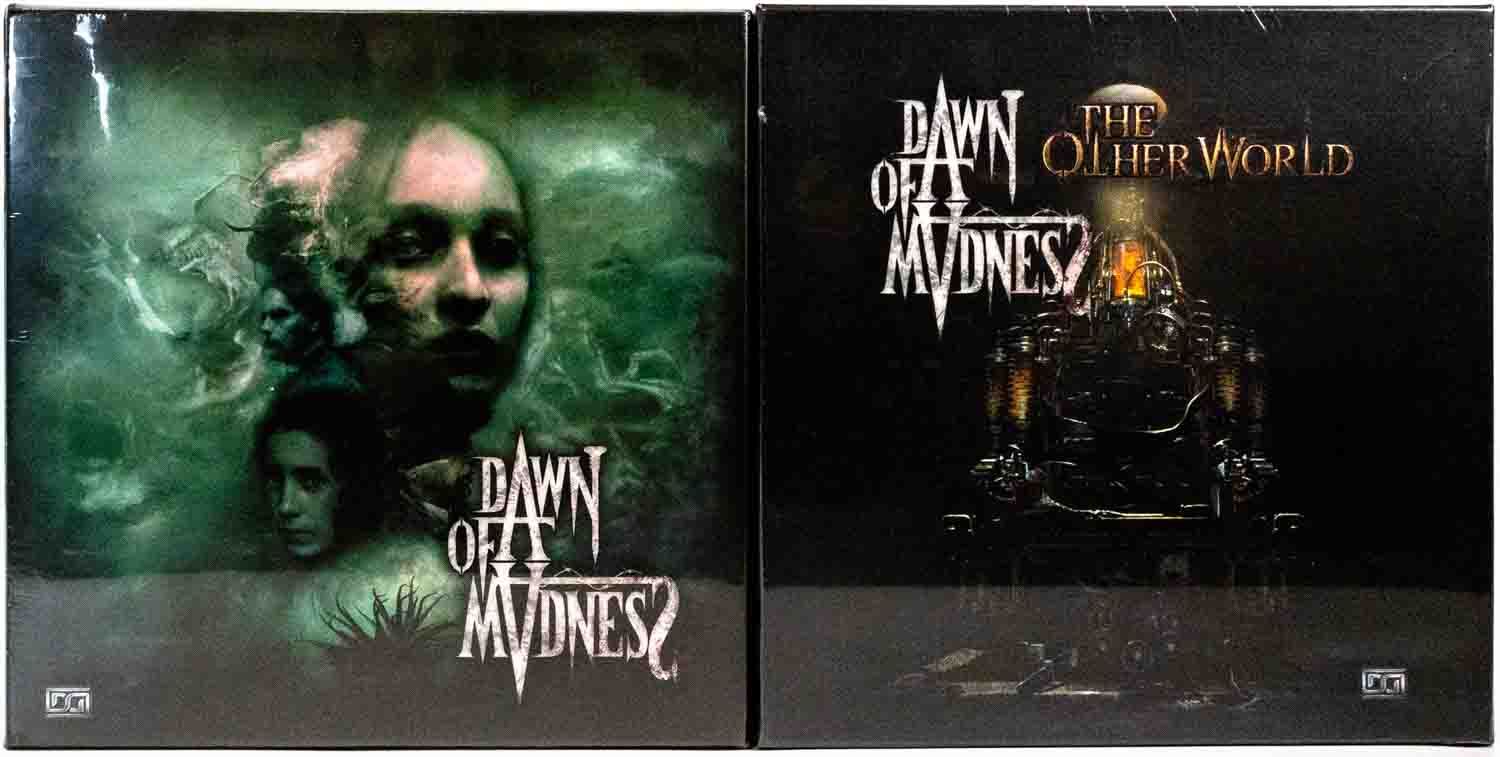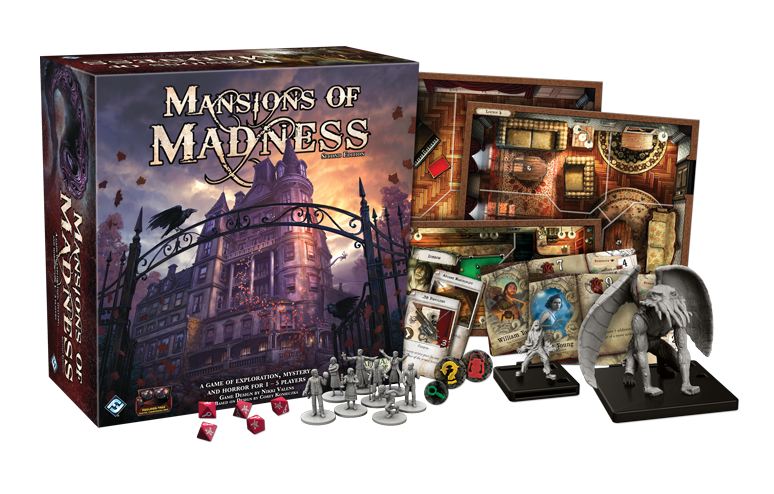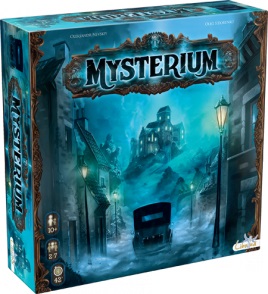2024 is home to some of the most terrifying board games you’ll ever encounter, but there’s more than just scares in these boxes. Below you’ll find creepy monsters, a devastating plague, and a Cthulhu cruise gone wildly wrong.
Whether you’re looking for something new to play this Halloween, or a game to keep you up in Winter’s dark, read on.
Cooperative Horror on Your Tabletop
Deep Madness appeared in 2018, intent to scare us with diabolical difficulty, undersea monsters, and a pervasive dread that accompanied your every move. That game’s been revised and optimized, leaving room for its designers (Chauncey, Roger Ho) to start somewhat fresh, yet stay equally evil with their newest title Dawn of Madness.
 Set in the same world as Deep Madness, this pseudo sequel is a narrative horror adventure for up to four players (though it’s very soloable). Leaving the ocean depths for the vast chasms of the mind, Dawn of Madness sees your wanderers lost amid a wild hellscape where strange monsters roam and fragments of your forgotten pasts glint in the distance. You’ll journey together, often needing to combine your abilities to persevere over puzzles and creatures. You’ll develop new abilities and explore each of your wanderer’s unique stories, each of which change based on the decisions you make.
Set in the same world as Deep Madness, this pseudo sequel is a narrative horror adventure for up to four players (though it’s very soloable). Leaving the ocean depths for the vast chasms of the mind, Dawn of Madness sees your wanderers lost amid a wild hellscape where strange monsters roam and fragments of your forgotten pasts glint in the distance. You’ll journey together, often needing to combine your abilities to persevere over puzzles and creatures. You’ll develop new abilities and explore each of your wanderer’s unique stories, each of which change based on the decisions you make.
Compelling enough, but Dawn of Madness supports that tasty description with fulfilling gameplay, particularly for fans of Arkham Horror and other narrative-focused titles. You’ll need to overcome dice checks from round to round, strategizing how to use limited resources and evade (or time your fights well) to take on the Terrors that spawn here and there. Players can specialize in ways both random and planned: you might find a shotgun and decide to spend your turns blasting monsters off the map so your pals can focus on completing objectives.
Dawn of Madness includes adjustable difficulty, which I’d recommend using to tailor the game to what you find enjoyable: if you want to focus on the story and less so on getting viciously devoured, go for it. And this is a game where narrative takes precedence, with playtimes similar to heftier scenarios in another classic horror game, Mansions of Madness.
All that said, Dawn of Madness is a special experience. A rich production, a wide range of play possibilities, and secrets that can only be unearthed through repeat plays. If you have a dedicated group that loves horror co-ops, or want a solo story-driven game to see you through to Spring, then Dawn of Madness is a world worth exploring.
Flashlights and Hidden Movement Horror
Hidden movement is a genre fit for spooky season and The Stifling Dark takes full advantage. Unlike most hidden movement games, The Stifling Dark doesn’t push the single hidden player to evade the others, but rather tasks the majority, the investigators, with escaping their singular menace. Your options for survival are many, whether it’s restarting a busted vehicle or breaking through a locked door in a frenetic race to freedom. At least that’s how it seems at the start, before the adversary begins to pick you off one by one.
push the single hidden player to evade the others, but rather tasks the majority, the investigators, with escaping their singular menace. Your options for survival are many, whether it’s restarting a busted vehicle or breaking through a locked door in a frenetic race to freedom. At least that’s how it seems at the start, before the adversary begins to pick you off one by one.
See, wounds in The Stifling Dark are more than just knocks against your total health. They carry negative effects, adding a sense of dread to the players as their narrow dodges carry lasting trauma. Working together to stay alive quickly becomes a must, and if you find enough gear or muster enough courage, the investigators can attempt to smack down the adversary for a combat-driven victory. The pressure, then, goes both ways: the adversary can’t putz around sharpening their knives, as the players could get too powerful.
The proverbial horror cherry on top comes in the form of flashlights, a mechanic that sees the players overlay a stencil on the board to show where they’re able to see amid the, er, stifling dark. If the adversary’s outside the light, they’re invisible, incentivizing cooperation while also giving the investigators a little more control over their risks. Maybe you can cover the hallway, and there’s no way the killer’s in that side room, right?
As you might be picking up, The Stifling Dark sits in the medium-weight realm, not a party game like Mysterium or a dense adventure like Cryptic Explorers. This is a meaty experience that’ll run a couple hours of tense cat-and-mouse play, with plenty of events, effects, and tactics to puzzle over. With asymmetric characters and enemies, there’s plenty of play here too. The sort of thing you can dig into all through Fall and Winter without seeing everything.
And if the idea of The Stifling Dark appeals but you’d like something a little simpler, consider last year’s Terrorscape, which is shorter and lighter, with ultimately a similar setup. Both promise tension, stories, and moments where the killer thinks they have the win in hand only to find the Final Girl waiting for them.
Worker Placement Vs. The Plague
In a vacuum, a euro game about defeating a plague and, in the process, building up your noble house to score sweet points might not seem that scary. In the post-COVID landscape, however, shrouding your game night in the eerie dread of a deadly, incurable disease will definitely prompt some squirming. Pest offers up this compelling game night option, throwing you and up to four other friends into a plague-stricken city with the goal of stopping the spread and, eventually, finding a cure.
A bit more compelling than trading in the Mediterranean, eh?
 Pest revolves around worker placement. Rather than competing for shared spots, though, you’re dropping your workers on a personal player board grid, with every spot triggering two actions. Those include researching better technology, sending your plague doctors around the land to cure infected citizens, or rebuilding crucial infrastructure. You’ll be doing this over six rounds, which take place over three years. Each round, in the way of nefarious pestilence, kicks off with a drawn card detailing some new diabolical event that must be dealt with.
Pest revolves around worker placement. Rather than competing for shared spots, though, you’re dropping your workers on a personal player board grid, with every spot triggering two actions. Those include researching better technology, sending your plague doctors around the land to cure infected citizens, or rebuilding crucial infrastructure. You’ll be doing this over six rounds, which take place over three years. Each round, in the way of nefarious pestilence, kicks off with a drawn card detailing some new diabolical event that must be dealt with.
This injection of randomness isn’t new in euro-style games—it keeps things from becoming ‘stale’ as players act out their unchanged plans—but can seem forced in the wrong setting. Like Spirit Island, Pest’s events feel appropriate: diseases and people’s reaction to the spreading unseen doom are often unpredictable. It’s thematic, and, in my opinion, a little chaos goes a long way towards keeping euros replayable.
As a crowdfunded production, Pest arrives with glitz and glamor. It’ll dominate your table with double-layered boards and great art, fitting right in with your Halloween plague doctor masks and a flickering candle or three.
A Cthulhu Cruise Gets An Expansion
A few years back, Fantasy Flight repurposed their classic Battlestar Galactica social deduction design into the Cthulhu-infused Unfathomable. Stuck aboard a ship under attack from all sorts of hideous horrors, you and your friends had to work together to stave off the monsters (or stab each other in the back). This year, Cthulhu lovers (always a well-catered group) get even more Unfathomable action with its new expansion, From the Abyss.
This is a more-is-better expansion, stacking on a minimum of new rules—saving imperiled people can now earn you helpful allies, for one—while adding variety to the gameplay you already enjoy. Shoggoths make their first Unfathomable appearance in all their disgusting glory, and you’ll get a bevy of new characters, items, and skills to throw into the mix.
characters, items, and skills to throw into the mix.
More interesting, though, are the prelude cards. As the name suggests, these nifty tweaks get dealt out at a few points during the game with varying effects. You might find a Deep One appearing in the worst place possible, or discover an unexpected supply cache in a closet. These little injections of chaos help keep a longer deduction game like Unfathomable from getting stale or solved, just like the events in Pest above. I love these wrinkles, both for the anticipation before the draw and the sudden challenge or pleasant surprise afterward.
If you have Unfathomable and play it regularly, this expansion should be an easy pick-up. Or, if you’ve not heard of this Lovecraft-inspired adventure, spooky season and the dark days of Winter are a great time to set sail on Unfathomable’s cursed voyage.
A Scary Game Night is a Good Game Night
We’ve written about terrifying board games before, but this subgenre just keeps on giving. Whether you’d prefer a comfortable euro with eerie trappings or a white-knuckle ride replete with traitors, murder, and horror, the games above will ensure you don’t sleep a wink this Halloween.
